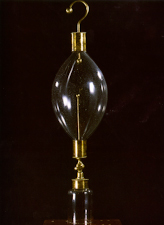
64 x 16
Glass, brass and copper wire
CAT. 1824 : N.II.151
Ovo electrico, que mostra a propagação da electricidade pelo vacuo.
Electric egg, which shows the propagation of electricity in a vacuum.
The electric egg, used in experiments to produce electrical discharges in rarefied atmospheres, comprises an oval glass vessel whose interior contains two brass rods ending in two small spheres. The metal rods communicate with brass terminals outside the vessel. One of the rods extends to the outside where it ends in a hook. The glass vessel has an outer terminal which can be connected to a vacuum pump to rarefy the air inside the egg.
The electric egg is connected to an electrostatic device by the hook, with the other terminal being grounded. Electrification is obtained by the action of the electrostatic machine causing electrical discharges between the terminal spheres on the two rods. When the pressure of the air inside the vessel is almost the same as the atmospheric pressure, luminous lines are observed branching out from a stronger luminous line. This luminous line winds, like lightning. When the air inside the egg is rarefied and pressure is low, the discharges are less winding and look like a violet, luminous ellipsoid. This ellipsoid is usually known as an electric egg, or philosophical egg, giving its name to the instrument.
As Sigaud de La Fond has suggested in his book, Description et Usage d'un Cabinet de Physique Expérimentale, spectacular configurations of electrical discharges are obtained when different shaped accessories are introduced. These instruments were used to study "electrical fire".
Sigaud de la Fond, Joseph-Aignan, Description et Usage d'un Cabinet de Physique Experimental, Paris, 1775, Vol. II, Pl. XXVI.